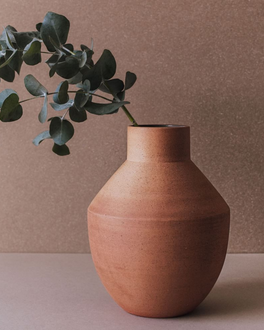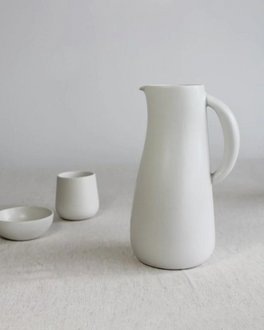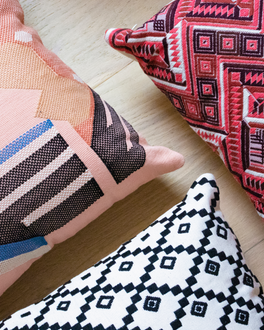
Hand poured taper candles in a delicate hue of white and peach, hang in the workshop of Casa Viviana waiting to be cut down to size. These custom works are made with beeswax, vegetable wax and natural dyes. Available at Knith.
Orphaned at a young age, Doña Viviana spent much of her childhood with her grandmother, María Hipólito Pablo. Through the years, they formed handmade candles using heritage molds from her great-grandmother. She made her first full candle at the age of eight, after learning various parts of the process. At fourteen years old, she ran away from home to marry a local weaver. In time, she found herself as the sole bread winner for their household. Given that she had small children to support, she decided to put her candle making knowledge to use.
Historically, artisans in this community were not paid for their skill and efforts. Instead, they produced candles in a barter system where they received a small amount of food from the Catholic church. Given this, not only were makers widely marginalized, it also left them in a perpetual state of poverty. This ongoing struggle was a palpable deterrent, and so, most makers abandoned their craft, in order to pursue other means of income generation.

Doña Viviana pours sun-bleached taper candles using a traditional jicara, which is the bottom of a dried gourd that’s often used for serving and as a tool in this region of Mexico.
Breaking with tradition, Doña Viviana expanded on the narrow candle design of the past, incorporating new shapes and sizes – with a special focus on roses. Of these innovations, she took two of her best pieces to the church for display. From there, people started approaching her with orders. She also walked to different communities with her candles, in order to expand her client base. As business increased, she opened her workshop to other local women, who served as apprentices and assisted with orders.
In this era in her traditional community, women were generally expected to stay home and take care of their families, rather than pursue an outside income – no matter their circumstances. Local authorities condemned Doña Viviana for breaking this norm. Despite this, she continued. As punishment, heritage candle molds that she inherited from her grandmother were confiscated, most of which have never been recuperated. While there’s now a handful of other candle makers in this town, it’s been noted that their knowledge likely traces back to Doña Viviana.

Individually formed beeswax cups are pierced onto brambles and left to bleach in the sun for weeks, until they slowly fade from yellow to white. This has been a part of the family creative practice for over 300 years.
Nowadays, Casa Viviana is comprised of three generations of immediate family members who collaborate on orders. They consistently innovate on an evolving roster of signature designs. Within this dynamic, women and men are treated as equals.
While they used to buy their beeswax locally, it’s become more complicated to source, given the effects of climate change. It now comes from the state of Chiapas, and their pieces are made from 90% beeswax and 10% vegetable wax. In order to bleach the wax from yellow to white, it’s mixed with fresh lime juice, heated, then a rounded piece of pottery is dipped into the hot mixture. This forms cup shapes, which are stacked, then individually pierced onto dried brambles and left to bleach in the sun.

Sitting on her knees on a palm petate – as is her custom – Doña Viviana creates a handmade beeswax rose using custom molds.
After the whitening process, they heat the wax again and expertly add natural dyes to create a range of vibrant hues. Pinks and reds are made with cochineal, yellow with marigold, blue with indigo and terracotta with fermented nuts, to name a few. The candles are gradually hand poured with a jicara over cotton wicks. A standard-sized taper requires roughly 200 pours. Once dry, the candles are then cut to size.
While their simple tapers are stunning, it’s their monumental, detailed works for which they’re most famous. In their community, there’s a long-standing tradition where the family of a groom commissions ornate candles for the marriage proposal process. These candles are sometimes taller than the makers themselves. They’re incorporated into a family march that’s lead by a town elder, which typically starts at dawn. These candles are locally known as ‘velas de concha’ since the traditional design featured seashell shapes that served as symbols of prosperity and abundance for the new couple.

Molds are typically made of wood, but other types are made from pottery and silicon. In order to make a layered rose, Doña Viviana carefully dips the mold into hot wax, then into a bucket of water, which cools the piece and helps the form to easily slip off into the water.
While this region of Mexico is changing rapidly, their Zapotec town firmly maintains their language and traditions. The community voluntarily operates under indigenous law known as ‘usos y costumbres’ and local land is not permitted for sale. Because of this, the walls of the local buildings in this community enclose rich culture, indigenous heritage and ancestral legacies. Due to the dedication and ingenuity of Doña Viviana, not only does the knowledge of her grandmother continue as a source of family income and pride, so does the tradition of candle making in her pueblo.


























